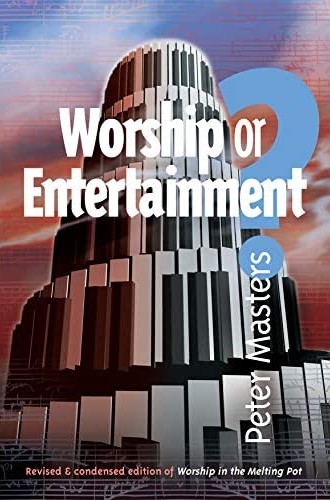Where will your church be five or ten years from now? With the adoption of contemporary music worship, many have already changed beyond recognition. Yet more will do so.
Contemporary worship
Our manner of worship is one of the most important issues confronting Bible churches today, and here is why. Six highly flawed styles of worship may be observed – often all mixed together. There is personal-pleasure worship, which puts the worshipper’s enjoyment in first place, rather than God’s desire. There is worldly-idiom worship, which borrows the current entertainment music of the world with its rhythms, instruments, actions and showbiz presentation, heedless of all the Bible’s warnings about loving the world. There is aesthetic worship, which imagines that orchestras, bands and instrumental solos are real expressions of worship, as if God is worshipped through these things, whereas Christ said – ‘God is a Spirit: and they that worship him must worship him in spirit and in truth.’ There is ecstatic worship, in which people work themselves into highly emotional and even semi-hypnotic states, whereas Scripture says that we must always pray and sing with the understanding. There is shallow worship, which reduces hymns to choruses conveying one or two elementary ideas, because solid spiritual themes are not wanted. There is informal worship, in which casual, jokey, trivia-injecting leaders turn churches into sitting rooms, so depriving the Lord of dignity, reverence, grandeur and glory.
It is as though Bible-believing churches have caught six viruses at the same time. How can churches survive in the power of the Spirit if their highest occupation is sick? How can God’s people keep themselves unspotted from the world, if the world has taken over the worship? How can we call lost souls out of the world, if we are the same as the world? Worship is certainly among the most important topics of the hour.
A brand new concept
In this article I would like to speak with great respect to fellow Christians, including pastors and church officers, who have adopted elements of contemporary worship. They have been persuaded that their reservations are merely a matter of taste and culture, and that they should introduce some of the new alongside the old, thus preserving the best of traditional worship. The problem with this is that the old and the new represent opposing concepts of worship, as these pages will show. The new breaks all the biblical principles recovered at the Reformation. Even the history of new worship rings alarm bells, and demonstrates the chasm between the old and the new.
The development of new worship is now fairly well known, and can be sketched here in a few sentences. It mainly began in California in the late 1960s, when many hippies turned to Christ, becoming known as the ‘Jesus people’. They worshipped with the very same style of song which they had known as hippies. Various Christian movements were formed to encourage them, among them the well-known Calvary Chapels. Their worship consisted mostly of one-verse choruses, endlessly repeated. The words were simple – simpler even than those of a traditional children’s chorus. There was seldom any confession of sin or the expression of any doctrine. However well-intended, the new worship was not shaped or influenced by any biblical model of worship, nor by the general practice of Bible-believing churches up to that time.
It was a form of worship fashioned and conceived in the womb of meditational mysticism, in which hippies in their hundreds and thousands would sit on Californian hillsides with eyes closed, swaying themselves into an ecstatic state, echoing their previous experience with drugs. Former hippies carried into their new Christian allegiance the same quest for emotional sensation to which they were accustomed, and, sadly, none of their Christian mentors showed them a better way.
New music
This new approach to worship rapidly advanced, merging with another new stream of ‘Christian’ songs written by those who simply wanted worship music to be like secular rock music. In other words, the latter wanted a ‘good time’ in a worldly sense. We need to be aware that new worship sprang from these two stables, namely, hippie mysticism and worldly Christianity. It was rapidly incorporated into the charismatic movement, from which the vast majority of new worship songs have come. Some years later, during the late 1980s, many sounder, more biblical churches began to adopt the new worship styles.
Such background information should lead us to great caution, but the biblical principles of the following pages should be the decisive factor in whether we accept or reject the new ways. We surely cannot blend opposing concepts. Is it worship or entertainment? – this is the question.
‘Contemporary Christian music’ has now captured countless congregations of every theological hue throughout the world, though not without many a battle. As a rule the chief strategy employed by the advocates of new worship has been to reduce the entire debate to a matter of taste, style and generation.
Those who keep to the ‘old’ ways are sometimes charged with a selfish refusal to adjust to changing culture. They have even been called the Pharisees of the 21st-century church, guilty of obstructing a great forward movement of God’s people and forcing division over non-essentials. For all this, large numbers of churches throughout the world still resist the new ways, believing that great principles are at stake.
Biblical worship principles
The trouble with the rhetoric of those advocating new worship is that they seem not to recognise, let alone discuss, historic, biblical principles of worship.
The trouble with the rhetoric of those advocating new worship is that they seem not to recognise, let alone discuss, historic, biblical principles of worship. It is as if there is nothing much about worship in the Bible. It is as if the Reformation never reformed worship back to the Scriptures. It is as though the bedrock definitions held over centuries have become invisible and non-existent. Where have these priceless and vital principles gone? Why are they hardly ever discussed? Do the advocates of new worship wilfully avoid them, or are they genuinely unaware of them? Certainly, it is an astonishing scene to find them passed over so easily.
The sixty-plus generation of believers remember that these principles were still being taught in their youth, but not any more. New definitions of worship have appeared which would never have been accepted as recently as fifty years ago – definitions which smash down the central principles of evangelical, Protestant Christian worship, taking us back to medieval and Catholic thinking. We will begin by identifying three major deviations from biblical standards (as recovered at the Reformation) typical of the entire modern worship movement. A fourth serious deviation appears in chapter 12.
Churches that have adopted modern worship songs and music to only a limited degree must take account of the deeply significant errors which govern the writers and composers of the new genre, most of whom embrace a shallow theology and hold ecumenical objectives.
This extract comes from Worship or Entertainment? by Dr Masters, available from the Tabernacle Bookshop.

Contents:
1. Worship or Entertainment?
2. Spiritual or Aesthetic Worship?
3. Rational or Ecstatic Worship?
4. Sacred or Profane Worship?
5. Let the Lord Define Worship
6. Brass, Strings and Percussion?
7. Services of Worship in the Bible
8. What Really Happened at Corinth?
9. Why Raise Hands?
10. When Hymns Were Born
11. Standards for Worthy Hymns
12. A Gift Most Rare
13. Reverence in Worship












